
* The Embraer company of Brazil has established a global reputation with its line of military and, more prominently, civil aircraft. One of the firm's earliest designs was a twin-turboprop light airliner, the "Bandeirante", which led to a smaller executive aircraft, the "Xingu", and a larger airliner, the "Brasilia". This document provides a history and description of the Bandeirante, Xingu, and Brasilia.

* The Brazilian government formally established "Empresa Brasileira de Aeronautica (EMBRAER)" as a state-owned corporation in 1968, though the firm would be privatized in the mid-1990s -- and the company name then elevated from an acronym to a word, written as "Embraer", that usage being retained below for convenience.
One of the first products built by Embraer was the "EMB 110 Bandeirante (Pioneer)" light airliner, the design of which actually well preceded the formation of Embraer. The Bandeirante began life in 1965, when the Brazilian Ministry of Aeronautics initiated the IPD-6504 program, the focus of which was a light utility air transport for both civil and military use, the Brazilian Air Force (FAB in its Portuguese acronym) being the intended military user. The aircraft was designed by a team under French aeronautical designer Max Holste, with the first of three prototypes performing its initial flight on 26 October 1968. This machine was designated the "EMB-100", or "YC-95" by the FAB, which placed an initial production order for a substantially refined follow-on, the "EMB-110 / C-95 Bandeirante". The aircraft was certificated in 1972, with initial deliveries to the FAB in early 1973 and commercial deliveries following.
* The EMB-110 / C-95 for the FAB provides a baseline for the Bandeirante family. The C-95 Bandeirante was a low-wing aircraft, made primarily of aluminum alloy, with an engine on each wing, a conventional tail arrangement, and tricycle landing gear. The wing was straight, with double slotted flaps inboard and ailerons outboard, plus a small wing fence outboard on each wing. There were no high-lift devices like slats, and de-icing kit was not standard. The aircraft was powered by Pratt & Whitney Canada (PWC) PT6A-27 turboprops providing 510 kW (680 SHP) each, driving three-bladed variable-pitch Hartzell propellers. All landing gear assemblies had single wheels and all retracted forward, the main gear tucking into the engine nacelles. The swept tailfin had a long forward fillet and the tailplane was flat, no dihedral or anhedral.
The C-95 had seating for 12 passengers, with three-across rows, and had two aircrew; galley and toilet were standard. There were emergency exits over each wing, and an "airstair" door in the rear. Avionics were conventional, with radios, navaids, and landing aids. The EMB-100 prototypes were visibly different in appearance from the EMB-110 production machines, being shorter, with a capacity of eight passengers, and circular instead of rectangular passenger windows; they were powered by PT6A-20 turboprops with 410 kW (550 SHP) each.
The FAB obtained 60 C-95 transports. The service also obtained four "EMB-110A / EC-95" machines, with the same airframe but configured for radio and electronic calibration system duties, carrying six systems specialists; plus six "EMB-110B / RC-95" photo-survey aircraft -- with Zeiss film cameras shooting through the floor of a belly tray, and improved navigation systems, the aircraft carrying five operators. The FAB referred to these specialized platforms with the name "Bandeirante Patrulha (Patrol Pioneer)" or just "Bandeirulha".
An "EMB-110B1" with a "quick-change" interior -- allowing it to be easily changed between the survey configuration and a 14-passenger airliner configuration -- was also built, with one sold to Uruguay and one to a civil operator. Sources also mention an "EMB-110BI", which was apparently a VIP transport with seating for nine passengers, plus a survey camera, but details are unclear; the variant history of the Bandeirante is very confusing, not well documented, and with many contradictions between sources.
___________________________________________________________________
EMBRAER EMB-110C BANDEIRANTE:
___________________________________________________________________
wingspan:
15.22 meters (50 feet 3 inches)
wing area:
29 sq_meters (312 sq_feet)
length:
14.23 meters (46 feet 8 inches)
height:
4.92 meters (16 feet 2 inches)
empty weight:
3,380 kilograms (7,450 pounds)
MTO weight:
5,600 kilograms (12,345 pounds)
max speed at altitude:
435 KPH (270 MPH / 235 KT)
service ceiling:
8,000 meters (26,250 feet)
range, max fuel:
2,220 kilometers (1,380 MI / 1,195 NMI)
___________________________________________________________________
The initial civilian airliner version, the "EMB-110C", was introduced into service in 1973. It was similar to the C-95 but with civilian kit, and seating configurations for 12, 15, or 18 passengers. The Uruguayan Air Force obtained five, while the Chilean Navy obtained three "EMB-110C(N)" machines with special kit, it appears primarily winterizations -- Chile's southern regions have a sub-polar climate.

There was also an "EMB-110E" executive transport, with 6 to 8 seats and plush accommodations. Sources mention an "EMB-110E(J)"; it is unclear if this was the same as the EMB-110E, or some variation of it. There was also a single "EMB-110S1" geophysical survey machine based on the EMB-110C, but with a magnetometer boom on the tail, larger wing tanks, and PWC PT6A-34 engines with 560 kW (750 SHP).
Sources mention an "EMB-110P", but give puzzling descriptions. It is generally described as an 18-seat airliner based on the EMB-110C; it was introduced roughly in parallel with the second-generation Bandeirantes, see below, so it may have been a "low-end" offering for the updated product line, incorporating refinements introduced at that time.
BACK_TO_TOP* The FAB wanted a more capable Bandeirante, so in 1977 Embraer introduced the "EMB-110K1 / C-95A", a pure cargolifter that featured:
20 C-95A transports were obtained by the FAB, followed by 31 "EMB-110P1K / C-95B" machines -- a "combi" (combination passenger-cargo) aircraft with a quick-change interior. There was also an "EMB-110P1K SAR / SC-95B" for search and rescue, with four bubble windows for observers, and accommodations for six stretchers.
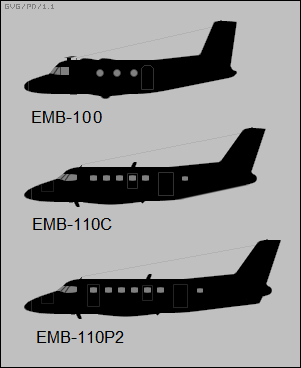
The second-generation C-95 military Bandeirantes were mirrored by the "EMB-110P1", a civil equivalent of the C-95B combi machine, with the double rear cargo door; and the "EMB-110P2", a pure airliner variant with up to 21 seats, and the double rear cargo door replaced by an aft airstair door, in addition to the airstair door forward -- door arrangements on the Bandeirante are another confusing subject.
___________________________________________________________________
EMBRAER EMB-110P2 BANDEIRANTE:
___________________________________________________________________
wingspan:
15.22 meters (50 feet 3 inches)
wing area:
29.1 sq_meters (313 sq_feet)
length:
15.1 meters (49 feet 6 inches)
height:
4.92 meters (16 feet 2 inches)
empty weight:
3,515 kilograms (7,750 pounds)
MTO weight:
5,670 kilograms (12,500 pounds)
max speed at altitude:
460 KPH (285 MPH / 250 KT)
service ceiling:
7,350 meters (24,100 feet)
range, max fuel:
1,900 kilometers (1,180 MI / 1,025 NMI)
___________________________________________________________________
Versions of the EMB-110P1 and EMB-110P2 with higher maximum take-off weight -- 5,900 kilograms (13,010 pounds), an increase of 230 kilograms (510 pounds) -- were introduced in 1981, being designated "EMB-110P1/41" and "EMB-110P2/41" respectively. The puzzling "/41" suffix indicated conformance with the "SFAR Part 41" regulation issued by the US Federal Aviation Administration.
In 1983, the commercial Bandeirantes were given a "facelift", with small improvements in kit and interior, better soundproofing, and most noticeably the flat tailplane replaced by a tailplane with a dihedral of ten degrees. The refined variants were designated "EMB-110P1A" and "EMB-110P2A", both with "/41" subvariants.
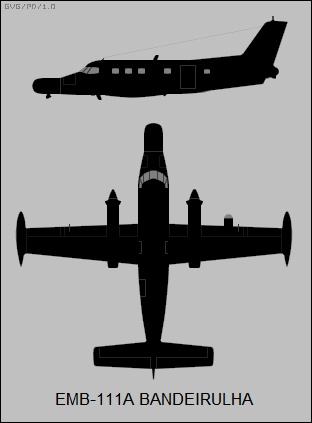
* Embraer also built a number of "EMB-111 Bandeirulha" maritime patrol machines, including 12 "EMB-111A" aircraft for the FAB Coastal Command, the first flying in 1977 and the type going into service in 1978, plus ten more machines obtained later; two EMB-111A machines for Angola, plus one for Gabon; and six "EMB-111A(N)" machines for Chile. They were based on the first-generation "short" Bandeirante airframe, but with:
* The Bandeirante, or "Bandit" as it was nicknamed by English-speaking operators, was popular, with a total of 494 of all variants delivered to end of production in 1990. It did much to make Embraer a global presence in the small airliner market, the company becoming an emblem of Brazil's emergence onto the world economic stage.
A good proportion of the Bandeirantes went into FAB service. The FAB found the type very useful, and set up an upgrade program to keep the Bandeirante in service. The new avionics systems, including a full glass cockpit, were provided by Aeroeletronica, the Brazilian arm of the Israeli Elbit company, with the updated aircraft designated "C/P-95". Initial flight of the C/P-95 was in 2010, with almost a hundred FAB Bandeirantes upgraded. There are plenty of civil Bandeirantes still in service, with cockpit upgrades available.
BACK_TO_TOP* The Bandeirante proving popular, Embraer decided to develop an executive transport aircraft based on it, resulting in the "EMB-121 Xingu", pronounced "shingoo" -- named after a Brazilian river and the native tribe that lives near it. Initial flight of the prototype was on 10 October 1976, with a pre-production machine flying on 20 May 1977. The Xingu featured the wing, engine, and landing gear scheme of the Bandeirante, with some modifications, mated to a new, smaller fuselage.
The Xingu was a sleek, attractive, low-wing aircraft, with a swept tailfin capped by a tee tail. There was a small wing fence outboard on each wing, and the tail featured a long forward fin fillet; there was a fixed ventral fin under the tail. The aircraft was powered by twin PWC PT6A-28 turboprops with 505 kW (680 SHP) each, driving three-bladed variable propellers. The Xingu had tricycle landing gear, the main gear having single wheels and retracting forward into the engine nacelles, the nose gear having twin wheels and also retracting forward.
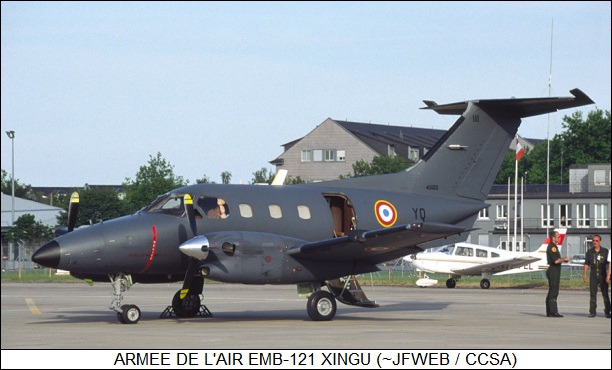
There was seating for up to six passengers along with two aircrew, with a fold-down "airstair" passenger door on the left rear side and an emergency exit above the right wing. There was a baggage hold in the nose, with access doors at both sides, as well as a baggage store at the rear of the cabin; toilet and galley were standard. The aircraft was pressurized and climate-conditioned, and featured a de-icing system. It was fitted with an avionics suite including autopilot, radios, landing aids and navaids, and a Bendix weather radar in the nose.
___________________________________________________________________
EMBRAER EMB-121 XINGU I:
___________________________________________________________________
wingspan:
14.14 meters (46 feet 5 inches)
wing area:
27.5 sq_meters (296 sq_feet)
length:
12.32 meters (40 feet 5 inches)
height:
4.94 meters (16 feet 2 inches)
empty weight:
3,475 kilograms (7,665 pounds)
MTO weight:
5,600 kilograms (12,345 pounds)
max speed at altitude:
475 KPH (295 MPH / 255 KT)
service ceiling:
8,320 meters (27,300 feet)
range:
2,650 kilometers (1,645 MI / 1,430 NMI)
___________________________________________________________________
The first six production Xingus were obtained by the FAB as VIP transports, these aircraft featuring five passenger seats and being designated "VU-9" in FAB service. Six more VU-9s were later obtained by the FAB, along with two used civilian Xingus that were given the designation of "EC-9". However, the biggest single user of the Xingu was the French military, which ordered a total of 41 -- including 25 "EMB-121AA" machines for the Armee de l'Air, the French air force, and 16 "EMB-121AN" machines for the Aeronavale, the French naval air arm.

An improved "EMB 121A1 Xingu II" was introduced in the 1980s, with the Xingu I prototype updated to the enhanced spec, and taking to the air for the first time in its new configuration on 4 September 1981. The Xingu 2 retained the same basic airframe as the Xingu I, but featured higher take-off weight, with more powerful PT6A-135 engines, with 560 kW (750 SHP) each, driving four-bladed props; a strake on each side of the tailcone; more fuel capacity; and a (eventually) a redesigned interior, with seating for up to nine passengers. Many Xingu Is were upgraded to Xingu II configuration.
A single prototype of a stretched "EMB-121B Xingu III" was flown in 1980, but did not enter production. The Xingu series was not particularly successful, with only 106 built, including prototypes, to end of production in 1987. The Xingu lingers in service.
BACK_TO_TOP* In the late 1970s, Embraer considered a pressurized version of the Bandeirante, the "EMB-110P3", notably featuring a tee tail with a swept tailplane. In parallel, the company considered what amounted to a scale-up of this same configuration as the "EMB-120 Brasilia", most significantly featuring fuselage diameter increased to 2.28 meters (7 feet 6 inches) from the Bandeirante's 1.72 meters (5 feet 8 inches). The initial prototype performed its first flight on 27 July 1983, being followed by two more prototypes. The Brasilia received Brazilian and US FAA certification in 1985, with initial customer deliveries that October.
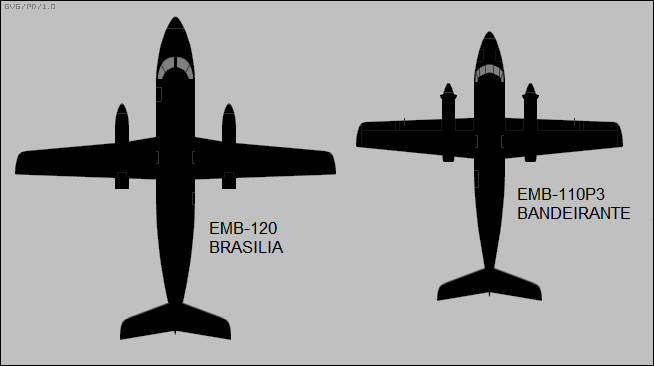
The initial production Brasilia had a clear resemblance to the Bandeirante -- a low-wing aircraft with straight wings, twin turboprops, and tricycle landing gear -- except that the Brasilia was bigger, and had the swept tee tail; it also had dual ventral strakes under the tail. It was powered by twin PWC PW115 turboprops with 1,120 kW (1,500 SHP) each, driving four-bladed Hamilton Sundstrand propellers. Production quickly moved on to uprated PW115 engines with 1,194 kW (1,600 SHP); an auxiliary power unit turbine was also available as an option.
The wing had a dihedral, with pneumatic de-icing boots on the leading edges; there were also de-icing boots on the tail surfaces. Flight control surface arrangement was conventional, with double slotted flaps; there were no high-lift devices such as slats. Gear configuration was like that of the Bandeirante, the only difference being that all gear assemblies had twin wheels to handle higher weights; all gear assemblies retracted forward.
___________________________________________________________________
EMBRAER EMB-120 BRASILIA:
___________________________________________________________________
wingspan:
19.78 meters (64 feet 11 inches)
wing area:
39.43 sq_meters (424.42 sq_feet)
length:
20 meters (65 feet 8 inches)
height:
6.35 meters (20 feet 10 inches)
empty weight:
7,140 kilograms (15,740 pounds)
MTO weight:
11,500 kilograms (25,355 pounds)
max speed at altitude:
610 KPH (380 MPH / 330 KT)
service ceiling:
9,150 meters (30,000 feet)
range, max fuel:
3,185 kilometers (1,980 MI / 1,720 NMI)
___________________________________________________________________
There were two aircrew, plus seating for 30 passengers and a flight attendant; there were three seats per row. There was an airstair door forward on the left side of the fuselage, with a large cargo door into a pressurized baggage hold on the left rear of the fuselage. There were three emergency exits, one over each wing and one behind the wing on the right. Toilet, galley, and wardrobe were standard for airliner versions.
From 1986, the "EMB-120RT", where "RT" meant "Reduced Take-off", became standard production. It featured PW118 engines with 1,343 kW (1,800 SHP) each; composite assemblies were also incorporated into the airframe at that time. An option was offered for a "hot-&-high" machine powered by PW118A engines -- with the same power ratings, but retaining power over a wider range of environmental conditions. An extended-range "EMB-120ER" variant became production standard in 1992, with specialized versions then turned out:
In 1994, the "EMB-120ER Brasilia Advanced", initially known as the "EMB-120X" or "Improved Brasilia" became production standard. The Brasilia Advanced was essentially an EMB-120ER with comprehensive detail improvements including noise reduction measures; improved ventilation and lighting systems; flight deck refinements; and a larger baggage / cargo compartment. Many existing Brasilias were updated to this standard.

The FAB did not have the same level of interest in the Brasilia as the service had in the Bandeirante, which is one of the reasons why the Brasilia's variant history is so much less bewildering than that of the Bandeirante. The FAB only obtained five "VC-97" VIP transports, equivalent to the EMB-120RT; there was talk of a "C-97", presumably a cargo or combi machine, but it didn't happen.
There was also talk of an "EMB-120EW" airborne early warning variant, and an "EMB-120SR" surveillance variant, but the Brazilian government decided to use the Embraer ERJ-145 jetliner for those roles instead. In addition, sources mention an "EMB-120K" maritime surveillance platform, but it never happened either. Production of the Brasilia ended in 2007, after over 350 had been built.
BACK_TO_TOP* Embraer worked on another twin-turboprop aircraft, the "CBA-123", that flew in prototype form but never entered production. It was a collaborative effort with Fabrica Argentina Materiales Aerospatiales (FAMA)" -- the joint effort being initiated in 1987, with "CBA" standing for "Cooperation Brazil-Argentina". The CBA-123 was effectively a shortened Brasilia with a new "supercritical" wing, twin pusher turboprops mounted on pylons alongside the tail, and other modifications.
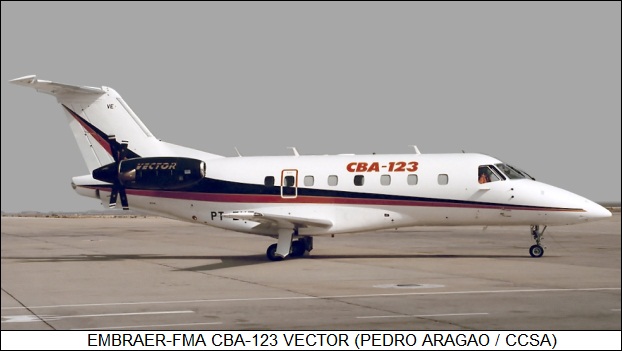
The first prototype of the "Vector", as it was called, performed its initial flight on 18 July 1990, with a second prototype following. They were powered by Garrett TPF351 turboprops with 970 kW (1,300 SHP), driving six-bladed contra-rotating props. A third prototype was in assembly when the soaring pricetag for a production aircraft and political problems led to the cancellation of the program. The two completed prototypes are now museum pieces in Brazil.
* This document was basically written from my stack of JANE'S ALL THE WORLD'S AIRCRAFT editions, there being not much written about these Embraer machines.
* Revision history:
v1.0.0 / 01 jan 13 v1.0.1 / 01 dec 14 / Review & polish. v1.0.2 / 01 nov 16 / Review & polish. v1.0.3 / 01 oct 18 / Review & polish. v1.0.4 / 01 aug 20 / Review & polish. v1.0.5 / 01 jun 22 / Review & polish. v1.0.6 / 01 may 24 / Review & polish. (+)BACK_TO_TOP
